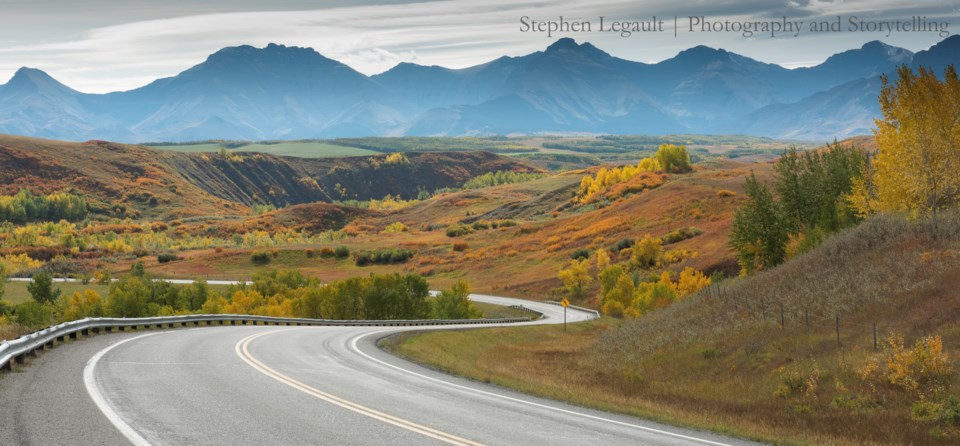CANMORE— After more than two years of hard work, a Canmore photographer will be giving audiences a peek behind the lens of his next book The Waters Within: Photographs and Stories from Waterton Lakes National Park and the Castle Wildland.
Stephen Legault has been working on a project exploring the ramifications of the 2017 Waterton National Park and Castle Wildland fires for two years. The project is still in the editorial stage and will be released as a book in late 2020.
“I’m always looking for opportunities to spend two years sleeping in the back of my truck and kicking around in the mountains,” Legault said with a grin. “Doing this project was a natural fit. I love Waterton and the Castle area.”
He will be presenting his work in a talk titled The Waterton Road: the Story Behind the Waterton Fire and the Protection of the Castle Wildland at artsPlace on Thursday (Nov. 7).
The talk at artsPlace is an opportunity to preview some of the images and stories that will appear in the book, Legault said, explaining that he has focused in on the September 2017 Kenow Wildfire that engulfed Waterton Lakes National Park and Castle Wildland.
Legault worked professionally in conservation for three decades and spent an extensive period of time on the campaign to establish the Castle area as a provincial park.
“I know the area. I love the history of it. I love the wildlife and the culture down there.”
The inspiration for the project struck after the fire, Legault said, explaining that he and his wife Jenn Hoffman headed to the area immediately to help friends who had survived the fire.
The fire was still burning in some parts of the park when they arrived on the scene.
“We were down right after the fire working with some folks at the Jenkins ranch that had gotten really burned,” Legault said. “We spent a couple of days pulling fence, driving fence posts and stringing new barbed-wire – It was at that point I realized what an extraordinary story there was to tell.”
The fire erupted quickly and consumed the valley, he said, estimating that about half the vegetative cover of Waterton was burned in the blaze.
“In a matter of hours the fire swept across the entire park,” he said. “This was an opportunity to look at how mountain ecosystems like Waterton come back after such an extraordinary event.”
It was an incredible experience walking through the post-fire devastation, he said, adding that he was struck by how dirty everything was from the soot.
“As a photographer, the light was surreal. It wasn’t hazy like you would normally have during a fire – it was unlike anything I had ever seen before,” Legault said. “It was almost like a steely blue light that sort of hung over the park and the ranch country for a couple of days … It made for really challenging photographic conditions, but really interesting.”
That day marked the start of a two-year project that aimed to capture the ecosystem that would emerge from the ashes of the Waterton and Castle Wildland areas.
Legault said he dove into exploring, shooting and interviewing people in the area to capture the reality of the fire and learn what they would do differently.
It was incredible seeing the growth that took place after the blaze, he said, adding that in certain areas within a few days to a week there was new growth once the ground had cooled where he could spot grass emerging from the ash.
“What’s amazing about ecosystems is how resilient they are," Legault said.
The fire burned from minimal severity to really intensely. Legault added that about 40 per cent of the area was burned so badly that the mineral soil was destroyed and it will take years for regrowth to occur.
In other areas where the flames were less intense, Legault said there are aspen trees that are already between a metre-and-a-metre and a half in height.
“The wildflowers in the last two years have been out of this world,” he said. “Completely off the charts beautiful.”
Legault estimates he took about 100,000 images over the course of the project, and it has been a “painful” process whittling the images down to the approximately 225 that will appear in the book.
His presentation at artsPlace is the first time he has previewed images before the final photos have been chosen for the book.
Legault said he is excited to talk about the project and gauge audience reactions to different photos.
The talk will feature photos from his work in Waterton and the Castle, including “tough to look at images” that showcase the devastation left by the fire's wake.
“It really is a hopeful story,” he said, explaining that there is a lot to learn from the Waterton fire. “Life is being restored.”
Fires like the one that took place in Waterton are becoming more frequent and intense, Legault said, adding that this should be a concern for people living in the Bow Valley.
He hopes that the project is able to provide insights into what is happening to the world’s climate and the steps communities can take to prepare for catastrophic natural disasters like wildfires.
“The possibility of a fire happening in this valley is very high,” Legault said. “It’s not a matter of if, it’s when.”
Legault will be presenting The Waterton Road: the Story Behind the Waterton Fire and the Protection of the Castle Wildland at artsPlace on Thursday (Nov. 7) at 7 p.m.




